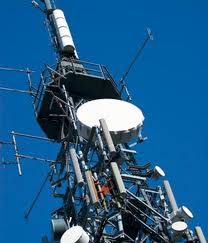 The introduction of the modem did this. It took a higher speed set point converted into an analog format that would be compatible with the lower quality analog line. So, this was a modulator, demodulator type of processes was taking place called modem. It takes complex modulations to include at the digital bits onto the analog signal. The demodulation to receiver recovers the digital bits. So, we start out digital, end up digital but transport over an analog method. And the common interface here was the Rx-232, or now the EIA-232 interface.
The introduction of the modem did this. It took a higher speed set point converted into an analog format that would be compatible with the lower quality analog line. So, this was a modulator, demodulator type of processes was taking place called modem. It takes complex modulations to include at the digital bits onto the analog signal. The demodulation to receiver recovers the digital bits. So, we start out digital, end up digital but transport over an analog method. And the common interface here was the Rx-232, or now the EIA-232 interface.
So, here’s some of the strides/seen in modem development, the ITU standard starting here with me with the V.21 on up through V.92. We can see that the data rates increase substantially both uplink and downlink and the importance here is that what happened, we were able to live on more complex including schemes to allow us to get the higher performance.
We get access procedure here for modems. We see this place with V.34 for higher type of modems and this is the protocol used and provides, remember we talked about bit-oriented transmission earlier in our modules, links management, flow control using windowing and we talked about the benefit of that when we discussed TCPIP and error detection using Frames Check Sequence and ARQ techniques. So, a lot of the things that we applied to datacom technologies apply equally well here. And another thing that’s important dealing with low bandwidth channels is data compression.
So, what do we have in a way of modem connections, originally modem to modem path was all analog? But, we could have a modem to modem path that is predominantly digital, certainly, if we’re using the existing telephone cloud as our communication’s path. Remember, modern telephones networks have been upgraded to digital formats on trunk lines and all leased lined are digital. So, the only part of most modern circuit switched networks that are analog are the edge connections from the local exchange out to the actual customers’ equipment, most of everything is digital. So, here’s what we’ve seen is that what we’re goals is to ultimate to become all digital.
Let’s talk a little bit about the top of the line in the modems here. V.90 and V.92, it was higher but symmetric bandwidth and that’s good because most of our applications will be built around needing a higher downstream bandwidth namely downstream to me from a service provider rather than meeting the same high speed of luxury basis. So, what we’re showing here are the highest theoretically achievable decorates and we’ve noticed these are – they’re certainly not acceptable by most of today’s applications. However, if you’re in an area where this is all that’s available, then, it’ll still work.
ISDN, Integrated Services Digital Network, there are parts of the world of this technology suffered some delays in being deployed but allows us now to extend the digital format from the local exchange out to the actual subscriber lines. The datacom path is all-digital and offers a higher, symmetric data rates to subscribers. Well, this is higher, but how much higher? The common configurations in the private rate exclusively the basic rate interface are 64kb/s or 128 kb/s. At the time that this was envision in technology, then this work high data rates but by today’s standards, they are not. Data compression can be used to improve the throughput and here’s what we would have in ISDN type of connection out to say a small office or home office environment.
So, remember, ISDN services fall into the category of being circuit switched type of services and support two rates. The basic rate interface is 2b, two bert channels which are the information channels and consist of two 64kb/s channels and a control channel or their primary rate interfacing consisting of 23 information channels, data channels, bert channels plus a control channel. Notice that there are two different channels. One, for the North American technology of 23b + d or 30b + d based on the European developed technology.
Do you have any questions? Well, if you do, use the question/comment box. Thanks for joining us and I’ll see you in an upcoming module.
Telecommunications Essentials Pt 4




